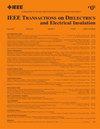Estimation of Secondary Electron Emission Coefficients for Dielectric Barrier Discharge Simulations
IF 3.1
3区 工程技术
Q2 ENGINEERING, ELECTRICAL & ELECTRONIC
IEEE Transactions on Dielectrics and Electrical Insulation
Pub Date : 2025-07-16
DOI:10.1109/TDEI.2025.3589990
引用次数: 0
Abstract
The inverter-driven motors are increasingly used in industrial and mobility applications, driving the demand for greater performance and reliability. Recent advances in power electronics have raised inverter output frequencies and slew rates, increasing the risk of discharge and insulation failure. A better understanding of discharge phenomena is thus essential. The authors are developing numerical simulations of dielectric barrier discharge (DBD) in twisted pairs of enameled wire. This study investigates the estimation and applicability of the secondary electron emission (SEE) coefficient (介质阻挡放电模拟中二次电子发射系数的估计
逆变器驱动的电机越来越多地用于工业和移动应用,推动了对更高性能和可靠性的需求。电力电子技术的最新进展提高了逆变器的输出频率和转换率,增加了放电和绝缘故障的风险。因此,更好地理解放电现象是必要的。作者正在进行漆包线双绞线介质阻挡放电(DBD)的数值模拟。本文研究了二次电子发射(SEE)系数($\gamma $)在DBD模拟中的估计和适用性,解决了经验数据的缺乏。结果,发现拟合对于从放电电压测量中估计$\gamma $是有效的。聚酰亚胺(PI)的估计值为$4.7\乘以10^{\text{-3}}$,聚乙烯(PE)的估计值为$7.5\乘以10^{\text{-3}}$。在DBD模拟中应用这些值表明在各种压力条件下估计放电电压的潜力。这些结果表明,DBD模拟可以提高漆包线双绞线放电现象预测的准确性。
本文章由计算机程序翻译,如有差异,请以英文原文为准。
求助全文
约1分钟内获得全文
求助全文
来源期刊
CiteScore
6.00
自引率
22.60%
发文量
309
审稿时长
5.2 months
期刊介绍:
Topics that are concerned with dielectric phenomena and measurements, with development and characterization of gaseous, vacuum, liquid and solid electrical insulating materials and systems; and with utilization of these materials in circuits and systems under condition of use.

 求助内容:
求助内容: 应助结果提醒方式:
应助结果提醒方式:


